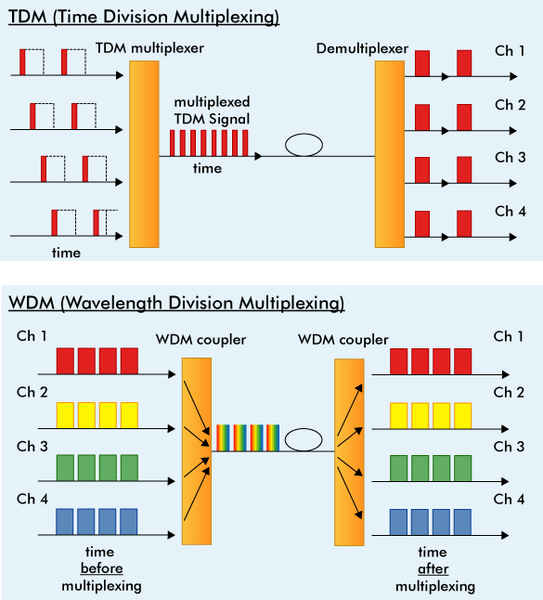- Related articles
- All Cisco GLC-FE-100LX's information (List price, Specs, Datasheet PDF, Compatibility matr
- The Things You Need to Know about 10GBASE-R Ethernet Standards
- What is GJFJH Fiber Optic Cable?
- Optical Transceivers for Cisco IE-2000-8TC-L Switch
- All Cisco DWDM-XFP-54.94's information (List price, Specs, Datasheet PDF, Compatibility ma
- Optical Transceivers for Cisco WS-C3750G-48PS-S Switch
- What is a transceiver in networking?
- Is It Possible to Interconnect SFP, SFP+ and XENPAK/X2…?
- What Is GYXTC8S Optical Fiber Cable?
- Optical Transceivers for Cisco SG350XG-48T-K9-UK Switch

Definition:
WDM is based on a well-known concept called frequency division multiplexing or FDM. With this technology, the bandwidth of a channel (its frequency domain) is divided into multiple channels, and each channel occupies a part of the larger frequency spectrum. In WDM networks, each channel is called a wavelength. This name is used because each channel operates at a different frequency and at a different optical wavelength (and the higher the frequency, the shorter the signal's wavelength). A common shorthand notation for wavelength is the Greek symbol lambda, shown as λ.
Time division multiplexing (TDM) provides a user the full channel capacity but divides the channel usage into time slots. Each user is given a slot and the slots are rotated among the users. A pure TDM system cyclically scans the input signals (incoming traffic) from the multiple incoming data sources (communications links, for example). Bits, bytes, or blocks of data are separated and interleaved together into slots on a single high-speed communications line.
Difference between TDM and WDM Multiplexing:
Multiplexing is a scheme that sends multiple signals or stream of information in the forms of analog data or digital data over a single physical trunk (also called as transmission lines /circuits/ channels).
Wavelength-division multiplexing (WDM) is a method of combining multiple signals on laser beams at various infared (IR) wavelengths for transmission along fiber optic media. Each laser is modulated by an independent set of signals. Wavelength-sensitive filters, the IR analog of visible-light color filters, are used at the receiving end. WDM is similar to frequency-division multiplexing (FDM). But instead of taking place at radio frequencies (RF), WDM is done in the IR portion of the electromagnetic spectrum. Each IR channel carries several RF signals combined by means of FDM or time-division multiplexing (TDM). Each multiplexed IR channel is separated, or demultiplexed, into the original signals at the destination. Using FDM or TDM in each IR channel in combination with WDM or several IR channels, data in different formats and at different speeds can be transmitted simultaneously on a single fiber.
Time-division multiplexing (TDM) is a method of transmitting and receiving independent signals over a common signal path by means of synchronized switches at each end of the transmission line so that each signal appears on the line only a fraction of time in an alternating pattern. It is used when the data rate of the transmission medium exceeds that of signal to be transmitted. This form of signal multiplexing was developed in telecommunications for telegraphy systems in the late 19th century, but found its most common application in digital telephony in the second half of the 20th century.
Conclusion:
TDM and WDM both are multiplexing techniques but used for different purposes and applications. TDM refers to time division multiplexing which uses single RF carrier to transmit the time multiplexed packet or frame. WDM refers to wavelength division multiplexing which uses different optical frequencies at various wavelengths to transmit the packet or frame of data separately over multiple channels after they are broken up into small blocks.























































